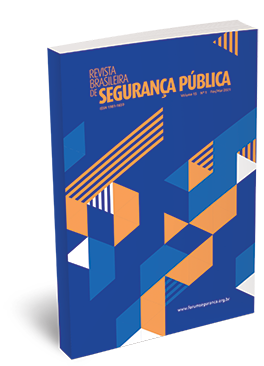The impacts of fear of crime on the leisure activities consumption in Brazil
DOI:
https://doi.org/10.31060/rbsp.2021.v15.n1.1179Keywords:
Fear of crime. Leisure activities. Economics of crime. Recursive bivariate Probit.Abstract
The high crime rates that Brazil presents generate countless impacts on society. Among these impacts there are the fear of being a victim of crime and the individuals’ behavioral changes. In this sense, this study aims to assess how the fear of crime affects the consumption of individuals' leisure activities, such as going to cinemas, shopping malls, parks, sporting events, fairs, bars, restaurants and concerts. To this goal, this study uses data from the National Victimization Survey of 2012 to estimate a bivariate recursive probit, a model capable of dealing with potential endogeneity problems. The results indicate that fear reduces the probability of leisure consumption in most of the investigated activities, with emphasis on sporting events, however, an increase was observed in the consumption of activities that offer more safety for clients, such as fairs and shopping malls. The study concludes that crime brings losses of well-being that go beyond the economic losses customarily accounted for in studies of crime costs, because it cannot be ignored that fear of crime is capable of reducing the individuals’ freedom and, consequently, to bring non-observed losses to economic activities.
Downloads
References
ALMEIDA, E. B. O consumo público de eventos esportivos: um olhar para além dos estádios de futebol. São Paulo: FGV, 2014.
ARENDT, J. N.; LARSEN, H. A. Probit models with dummy endogenous regressors. SSRN Electronic Journal, 2006.
BECKER, G. S. Crime and punishment: An Economic Approach. Journal of Political Economy, v. 76, n. 2, p. 169-217, 1968.
BECKER, G. S.; RUBINSTEIN, Y. Fear and the Response to Terrorism: An Economic Analysis, Centre for Economic Performance, LSE, Chicago, 2004.
BRANDS, J.; VAN AALST, I; SCHWANEN, T. Safety, surveillance and policing in the night-time economy: (Re)turning to numbers. Geoforum, v. 62, p. 24-37, 2015.
BRANDS, J. Fear of crime and affective ambiguities in the night-time economy. Urban Studies, v.52, p. 439-455, 2013.
CARDOSO, M. L. F; LOUREIRO, P. R. A. Desempenho econômico de atividades comerciais noturnas e criminalidade. Brasília: UNB, 2017.
CHATTERTON, P.; HOLLANDS, R. Theorizing urban playscapes: producing, regulating and consuming youthful nightlife city spaces. Urban Studies, v. 39, p.95-116, 2002.
CLARKE, R. V. Situational Crime Prevention: Theory and Practice. The British Journal of Criminology, v. 20, n. 2, p. 136-147, 1980.
CLARKE, R. V. Situational Crime Prevention. Crime Justice, v. 19, p. 91–150, 1995. DOI: https://doi.org/10.1086/449230.
COHEN, L. E.; FELSON, M. Social Change and Crime Rate Trends: A Routine Activity Approach. American Sociological Review, v. 44, p. 588-608, 1979.
CORNISH, D. B.; CLARKE, R.V. Modeling Offenders' Decisions: A Framework for Research and Policy. Crime and Justice, v. 6, p.147-185, 1985.
CRAWFORD, D.; GODBEY, G. Reconceptualizing barriers to family leisure. Leisure Sciences. v. 9, p. 119-127, 1987.
DEFRONZO, J. Fear of crime and handgun ownership. Criminology, v. 17, n. 3, p. 331-340, 1979.
DOLAN, P; PEASGOOD, T. Estimating the economic and social costs of the fear of crime. British Journal of Criminology, v. 47, n.1, p. 121-132, 2006.
FARRALL, S.; GADD, D. The Frequency of the Fear of Crime. British Journal of Criminology, v. 44, n. 1, p. 127-132, 2004.
FEATHER, P.; SHAW, W. D. Estimating the Cost of Leisure Time for Recreation Demand Models. Journal of Environmental Economics and Management, v. 38, n. 1, p. 49–65, 1999.
FERRARO, K.F. Fear of crime: Interpreting victimization risk. SUNY press, 1995.
GAROFALO, J. Victimization and fear of crime. Journal of Research in Crime and Delinquency, n. 16, p. 80-97, 1979.
GAROFALO, J. The fear of crime: Causes and consequences. The Journal of Criminal Law and Criminology, v. 72, n. 2, p. 839–857, 1981.
GREENBAUM, R.T.; TITA, G. E. The Impact of Violence Surges on Neighborhood Business Activity. Urban Studies, v. 41, n. 13, p.2495–2514, 2004.
GREENE, W. H. Econometric Analysis. 7 ed. New Jersey: Prentice Hall, 2002.
GRONAU, W.; KAGERMEIAR, A. Key factors for successful leisure and tourism public transport provision. Journal of Transport Geography, v.15, n.2, p 127-135, 2007.
HALE, C. Fear of Crime: A Review of the Literature. International Review of Victimology. v.4, n.2, p. 79-150. 1996.
HAVIGHURST, R. J.; FEIGENBAUM, K. Leisure and Life-Style. American Journal of Sociology, v 64, n. 4, p. 396-404, 1959.
HE, K. A behavior study of transport impacts of mega events. University of Southampton, Faculty of Engineering and the Environment, 2012.
HELMS, G. Towards Safe City Centres? Remaking the Spaces of an Old Industrial City. University of Glasgow, 2008.
HINDELANG, M. J.; GOTTFREDSON, M. R.; GAROFALO, J. Victims of personal crime: an empirical foundation for a theory of personal victimization. Cambridge, Mass.: Ballinger Pub. Co., 1978. 324 f.
JARA-DÍAZ, S.R.; FARAH, M. Transport demand and user's benefits with fixed income: the goods / leisure trade - off revisited. Transportation Research, v.21, p. 165-170, 1987.
LEE, Y. G.; BHARGAVA, V. Leisure Time: Do Married and Single Individuals Spend It Differently? Family and Consumer Sciences Research Journal, v. 32, p. 254-274, 2004.
LISKA, A E.; SANCHIRICO, A.; REED, M. D. Fear of crime and constrained behavior specifying and estimating a reciprocal effects model. Social Forces, v. 66, n. 3, p. 827–837, 1988.
MADDALA, G. S.; LEE, L. F. Recursive Models with Qualitative Endogenous Variables. Annals of Economic and Social Measurement, v. 5, n. 4, p. 525–545, 1976.
MOEN, B. E.; RUNDMO, T. Explaining Demand for Risk Mitigation, Trondheim: Rotunde Publikasjoner no. 86, 2004.
MOREIRA, F. A. Demanda e oferta de entretenimento: um estudo do segmento de Baixa Renda do distrito de Itaquera na Cidade de São Paulo. São Paulo: FGV, 2006.
OLIVEIRA, C. The impact of private precautions on home burglary and robbery in Brazil. Journal of Quantitative Criminology, v. 34, n.1, p. 111-137, 2018.
ORTHNER, D. K. Leisure Activity Patterns and Marital Satisfaction over the Marital Career. Journal of Marriage and Family, v. 37, n. 1, p. 91-102, 1975.
OWEN, J. D. The Demand for Leisure. Journal of Political Economy, v. 79, n. 1, p. 56–76, 1971.
PAIN, R. Place, social relations and the fear of crime: a review. Progress in Human Geography, v. 24, n. 3, p. 365-387, 2000.
PHANEUF, D. J.; SMITH, V. K. Recreation Demand Models. Handbook of Environmental Economics, Chapter 15, 2, 671-761, 2005.
SÁ-EARP, F; SROULEVICH, H. O comportamento do consumidor de produtos culturais e os combos de entretenimento. In: MELO, Victor A. (Org.). Lazer: aspectos históricos, configurações contemporâneas. São Paulo: Alínea, 2009.
SÁ-EARP, F. O espectador eventual: notas sobre a demanda por cinema no Brasil. Políticas Culturais em Revista, v. 2, n. 1, p. 77-87, 2009.
SHAW, S M. Gender and Leisure: Inequality in the Distribution of Leisure Time. Journal of Leisure Research, v.17, p. 266-282, 2018.
SILVA, B. F. A.; BEATO FILHO, C. Ecologia social do medo: avaliando a associação entre contexto de bairro e medo de crime. Revista Brasileira de Estudos de População, v. 30, p. S155-S170, 2013.
WARR, M. Fear of victimization: Why are women and the elderly more afraid? Social Science Quarterly, v.65, p.681-702, 1984.
ZANI, B.; KIRCHLER, E. When violence overshadows the spirit of sporting competition: Italian football fans and their clubs. Journal of Community. Appl. Soc. Psychol., v.1, p. 5-21, 1991.
Downloads
Published
How to Cite
Issue
Section
License
Copyright (c) 2021 Revista Brasileira de Segurança Pública

This work is licensed under a Creative Commons Attribution 4.0 International License.
Licensing
The Brazilian Journal of Public Security uses the Creative Commons License as a form of licensing for its published works. The license used follows the CC BY 4.0 - Attribution 4.0 International model.
To see the permitted rights please go to the full licence or to our Copyright and Licensing page.



